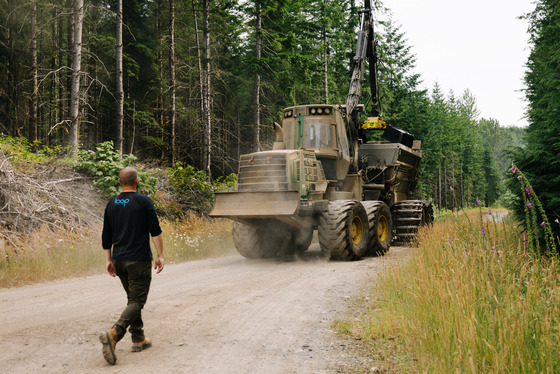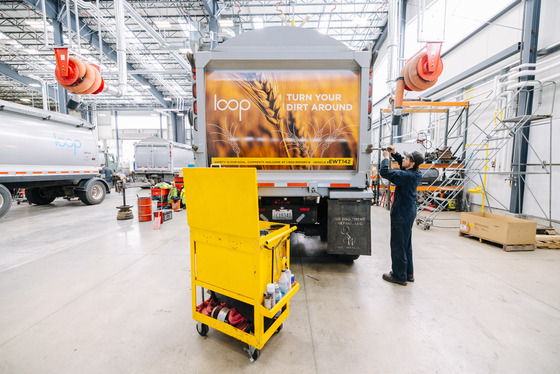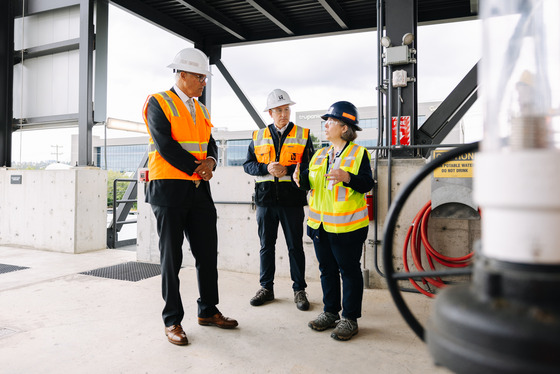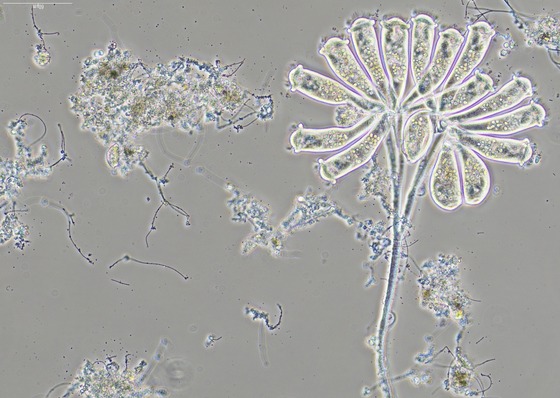|
 Ben Axt of the Wastewater Treatment Division’s Resource Recovery team walks behind the large equipment used to distribute biosolids in the forest’s challenging terrain.
Our wastewater treatment process produces around 340 tons of biosolids each and every day. It has to go somewhere but it’s more than “waste”, it’s actually a resource. We carefully treat the biosolids produced from all the human poop and food waste, and turn it into a reliable, consistent, and safe product called Loop®. This is a nutrient-rich soil amendment that we sell to farms and forestry operations as an endlessly renewable resource.
This month, we hosted members of the Metropolitan Water Pollution Abatement Advisory Committee (MWPAAC), on a tour of one of the spots where we apply Loop® biosolids at the Snoqualmie Tree Farm. The group got to see how we apply it in the unique conditions of a timberland forest.
Spanning 90,000 acres (that's nearly twice the size of Seattle!), the Snoqualmie Tree Farm has benefitted from nitrogen and other essential nutrients in biosolids that promote tree growth since 1987.
A substitute for commercial fertilizers, Loop has the added benefits of improving habitat conditions for wildlife and storing carbon in the soil to offset climate change.
Learn more about Loop® biosolids.
|
|
 David Swezey, a mechanic with Skagit Transportation, greases and inspects safety locks on a trailer in one of the bays of the North Bend facility.
Nestled just off I-90 in North Bend, the ‘Loop Truck Shop’ (officially called the Loop Truck Maintenance Facility) has earned the prestigious eco-label, LEED Platinum certification. Since it opened its doors in early 2023, this state-of-the-art facility combines sustainability with functionality.
From solar panels and sustainable building materials to spacious bays and full-service repair and maintenance, the facility goes the distance in keeping these trucks in tip-top shape for their hauls across Washington.
|
|
 Tom Bauer (left), the plant manager of West Point, talks with Amritha Prakash and Christopher Kleeves during an intern tour of the treatment plant.
The college intern program at King County Wastewater Treatment Division (WTD) is in full swing this summer, with 15 interns from schools nationwide. These undergraduate and graduate students have joined our education, operations, finance, and environmental planning teams to gain invaluable work experience and contribute their expertise until they return to school in the fall.
"It's a great opportunity to get a glimpse of what engineering work in the wastewater field is like and help me explore diverse career opportunities for my future,” said Chris Kleeves, an undergraduate engineering intern who’s working with the operations and maintenance crews at West Point Treatment Plant.
"I find WTD's ability to transform waste into numerous resources to be incredibly fascinating and inspiring,” said Celeste Wrye, a WaterWorks Grant Program graduate intern.
Learn more about our internship program!
Check out our job openings!
|
|
 A portion of the area of study can be seen in this aerial photo looking west over the SODO neighborhood with the Port of Seattle in the background. Photo by King County Metro
We are advancing plans to control pollution from five combined sewer overflow (CSO) outfalls where the Duwamish River meets Elliott Bay in Seattle’s SODO neighborhood. The Mouth of Duwamish Wet Weather Facilities is a multi-year project that, when complete, will help prevent stormwater and wastewater from entering the Duwamish River during heavy storms.
We want to hear from you! Please visit our online open house to explore plans for Mouth of Duwamish Wet Weather Facilities and participate in our survey to share your insights. The online open house is available through Aug. 31.
Come meet our team in person at the 18th annual Duwamish River Festival this Saturday, Aug. 3, at People’s Park (8700 Dallas Ave. S. in South Park).
|
|
 A lone kayaker takes a sunset paddle in Puget Sound.
Speaking of controlling combined sewer overflows, we recently announced a significant milestone in our ongoing efforts to improve water quality in Puget Sound and our local waterways.
Alongside Seattle, King County has successfully negotiated changes to our consent decree with federal and state regulators that will enable us to build more equitable, climate-resilient projects that will protect water quality in our region for decades to come, while supporting sustainable sewer rates.
Last week, King County Council approved the consent decree changes, bringing us one step closer to finalization.
Learn more about our CSO investments.
|
|
 Rebecca Singer, wastewater operations manager, leads Gov. Jay Inslee and Executive Dow Constantine on a tour of the Georgetown Wet Weather Treatment Station on June 17.
King County Executive Dow Constantine recently hosted Gov. Jay Inslee at our Georgetown Wet Weather Treatment Station to announce a series of community decarbonization grants from the state’s Climate Commitment Act. Georgetown will receive $200,000 to add approximately 182 solar panels on the roof of the treatment building. Wastewater treatment is an energy-intensive operation, and this project will help reduce the facility’s greenhouse footprint. We expect to have the solar array installed later this year!
Wastewater Operations Manager Rebecca Singer led the tour, showcasing the facility's innovative features. Representatives of the Duwamish River Community Coalition also joined us to highlight the facility’s positive impact on the community and a cleaner Duwamish River. For more details on our other solar initiatives – including the panels going up at West Point and Brightwater – check out the latest Clean Water Stories blog post.
|
|
 Microscopic photo of microbes, specifically a colony of stalked ciliates.
Microbes are the unsung heroes in our wastewater treatment plants, breaking down pollutants and cleaning the wastewater. Hundreds of species of microbes, including bacteria and protozoa like the stalked ciliates (pictured above), as well as rotifers and nematodes, are essential for maintaining a stable and healthy microbial ecosystem.
With their graceful, inverted tulip or bell-shaped bodies, the hair-like cilia of stalked ciliates create a water vortex around their mouths to feed on bacteria-rich wastewater. To keep these “bugs” healthy, they need a good supply of oxygen, which we provide in our aeration tanks.
The stalked ciliates (and other beneficial microbes) get to work by eating and metabolizing the organic material back down into the basic components: nitrogen compounds, carbon dioxide and water! Afterward, the water is disinfected before it’s piped to Puget Sound.
Curious to learn more about the fascinating process of wastewater treatment? You can go on a tour of one of our facilities! Check our Events page for upcoming treatment plant tours to learn how we protect public health and the environment.
|
|
 Go Green Night will return on July 31 at Movies at Marymoor for the screening of 'Barbie.' So grab your blanket, and we'll see you out there!
We partnered with the King County Department of Natural Resources and Parks for a great giveaway on our newly launched Instagram! Would you like to win a pair of tickets to any 2024 Marymoor Live concerts in August and September?
Here's how to enter 👇
✨ Head to instagram.com/KingCountyWTD
✨ Like the giveaway post
✨ Tag a nature-loving bestie
✨ Make sure you're following us and our buds!
The winner will be announced on Aug. 1.
Our Instagram account is a great spot to learn about exciting project updates, see behind-the-scenes photos of our treatment facilities, and find helpful tips for keeping our area's waterways clean.
|
|
|
|
|